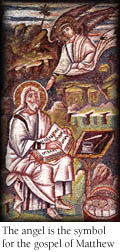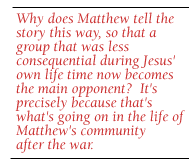The Gospel of Matthew
Jesus as the new Moses.John H. Morison Professor of New Testament Studies and Winn Professor of Ecclesiastical History Harvard Divinity School
JESUS IN MATTHEW - A MAN FROM ISRAEL
 The Gospel of Matthew is concerned with the position of these early Christian
churches within Israel, or in its relationship to what we call Judaism. And
these are concerns that belong to the time after the fall of Jerusalem. How do
these Christian communities, who don't even call themselves Christian, and
probably don't even have a consciousness that they're something different than
Israel, how do they relate to others who claim to be Israel? And it's
very important that Jesus for Matthew is fully a man from Israel. Therefore,
Matthew begins his gospel by taking all the genealogy of Jesus; he wanted to
show that Jesus was the son of David, and now traces this back to Abraham. For
Matthew, Jesus is not the son of David, but he is the son of Abraham. He is
truly a man from Israel. And thus Jesus' teaching also is one that is fully in
the legitimate tradition of Israel's teaching of the law. So in Matthew, not
in any other gospel, we have Jesus saying he has not come to dissolve the law
but to fulfill it. And that no part of the law will disappear....
The Gospel of Matthew is concerned with the position of these early Christian
churches within Israel, or in its relationship to what we call Judaism. And
these are concerns that belong to the time after the fall of Jerusalem. How do
these Christian communities, who don't even call themselves Christian, and
probably don't even have a consciousness that they're something different than
Israel, how do they relate to others who claim to be Israel? And it's
very important that Jesus for Matthew is fully a man from Israel. Therefore,
Matthew begins his gospel by taking all the genealogy of Jesus; he wanted to
show that Jesus was the son of David, and now traces this back to Abraham. For
Matthew, Jesus is not the son of David, but he is the son of Abraham. He is
truly a man from Israel. And thus Jesus' teaching also is one that is fully in
the legitimate tradition of Israel's teaching of the law. So in Matthew, not
in any other gospel, we have Jesus saying he has not come to dissolve the law
but to fulfill it. And that no part of the law will disappear....
Matthew has some hesitation to show that this is also the community for the gentiles. It is clear that yes, there is the gospel for the gentiles. The disciples at the end of the gospels are sent out to all nations, and are asked to teach them what Jesus had taught the disciples. That is, teach them also that Jesus had not come to dissolve the law. Now apparently the understanding of the law is not identical with that of emerging Judaism after the destruction of Jerusalem. Because notice there's no emphasis on ritual law. No circumcision, no Sabbath commandment. So the ritual commandments of the law have disappeared. But nevertheless, Matthew wants this to be understood as a legitimate new interpretation of the law of Moses.
Professor of Classics and Director of the Religious Studies Program University of Texas at AustinMATTHEW'S JEWISH CHRISTIAN COMMUNITY
 Who was Matthew writing for?
Who was Matthew writing for?
Matthew's gospel is clearly written for a Jewish Christian audience living within the immediate proximity of the homeland itself. Matthew's is the most Jewish of all the gospels. The community for which Matthew was written was a Jewish Christian community that was encountering some new tensions in the period of reconstruction after the first revolt. It would appear that they've been there for quite some time. They actually show a consciousness of an older legacy of Jesus' tradition, going back to before the war. But now they're experiencing new tensions and new problems in the aftermath of the revolt as a political and social reconstruction is taking place.
 What is the reconstruction that is taking place, just in every day human
terms?
What is the reconstruction that is taking place, just in every day human
terms?
What may lie behind the social tensions reflected in Matthew's gospel may be the massive population shift that resulted after the first revolt. When most of the Jewish population moved to the Galilean region of north. That's the situation [in] which Matthew's gospel seems to be written. But, as this new population has to be organized, the new political realities of village life begin to produce some new tensions, as well. It's in this context that the Pharisaic movement would become the new dominant force for the reconstruction of Jewish life and thought in the period after the first revolt. From the early Pharisaic tradition would emerge the Rabbinic tradition and ...the Rabbis as the leaders and teachers of Jewish tradition and interpreters of Torah, of law, would set the stage for the normative development of Judaism, down to modern times.
CONFLICT IN MATTHEW'S COMMUNITY
Now, we have to remember that it's precisely in Matthew's gospel that the Pharisees are Jesus' main opponents throughout his life. Now, in Jesus' own times, the Pharisees weren't that prominent a group. Why does Matthew tell the story this way, so that a group that was less consequential during Jesus' own life time now becomes the main opponent? It's precisely because that's what's going on in the life of Matthew's community after the war. The Pharisees are becoming their opponents and we're watching two Jewish groups, Matthew's Christian Jewish group and the local Pharisaic groups in tension over what would be the future of Judaism. Naturally, they have very different answers.
What are their answers? What are the specific things they disagree about?
Matthew's community observes Torah. In Matthew, in the Sermon on the Mount, Jesus says, "think not that I've come to destroy the law and the prophets - I've come not to destroy them but to fulfill them." In Matthew, Jesus is a proponent of Torah piety, just like the Pharisees. So, on the one hand, they follow the law in a way that makes them very good Jews. On the other hand, there are tensions over what is the proper form of piety for them.
One of the indications of the situation of Matthew's community comes up when Matthew's gospel gives regulations for how to discipline members within the community if they get out of hand. It says if one of the members of the congregation sins, go and tell them about it, and if they refuse to listen to you, take a friend and tell them about it and if they refuse to listen to them, take them to the church and if they refuse, kick them out. You actually throw them out of the church, out of the congregation. But, what's really interesting in this, this set of disciplinary regulations from Matthew 18, is that when you kick them out, when you excommunicate them or disfellowship them, you say, "you now are a gentile and a tax collector." You treat them as an outsider. But if kicking someone out means they're considered a gentile, those who are inside clearly must think of themselves still as thoroughly Jewish.
JESUS AS MOSES
The way Matthew then tells the story of Jesus draws on a lot of symbols from Jewish tradition that really convey a picture of Jesus. Jesus goes up on to a mountain to teach and there talks about the law. He looks like Moses. Jesus delivers five different sermons of this sort, just like the five books of Torah. There are a lot of elements in this story that resemble Moses' traditions, from the killing of the babies, in the birth narrative, to the Sermon on the Mount, to even to the way that Jesus dies, just like some of the prophets died, as martyrs to their prophetic calling.
![]()
Read more on the Gospel of Matthew in this essay by Marilyn Mellowes.
